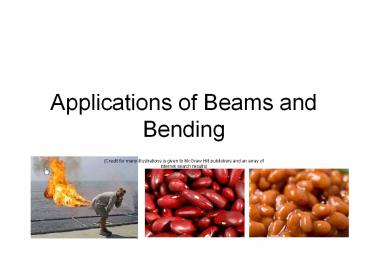Applications of Beams and Bending PowerPoint PPT Presentation
1 / 31
Title: Applications of Beams and Bending
1
Applications of Beams and Bending
- (Credit for many illustrations is given to McGraw
Hill publishers and an array ofinternet search
results)
2
Parallel Reading
Chapter 6
Section 6.4 Design of Beams for Strength Section
6.5 Flexural Stress in nonhomogeneous beams (Do
Reading Assignment Problem Set 6B)
3
Lets Try Using Our Radius of Curvature Formula
Old McDonald had a beam The beam had a Youngs
Modulus Of 165 GPa If was acted on by a 3
KNm Bending couple
What are the maximum tensile and compressive
stresses and radius of curvature?
4
Our Key Formulas
Obviously we are going nowhere with this Until we
get the Inertia of our beam
5
Getting I
We previously got our centroid using a weighted
average of area but now we are after the second
moment - I
90 mm
Getting the inertia of each of the
component rectangles about their own axis would
not be a trick. There is a formula for that.
20 mm
40 mm
30 mm
Of course we want the moment about the Centroid
axis
6
Fortunately We Have the Parallel Axis Theorem
90
The moment of inertia of an element about A
different axis is the moment of inertia of The
element around its own axis
20
Plus the area of the element time the Distance
between the axis squared.
1800
12
7
So Work Through and Get the Inertia
From component 1
From component 2
90
30
1800
1200
20
18
12
40
1800
1200
8
Stresses Go Down Easy Now
Our basic formula
Tension side on top s max 76 MPa (Positive is
for tension)
Compression side on bottom s max -131.3 MPa
(Negative is for compression)
9
Now for the Radius of Curvature
10
Lets Try Bending a Beam
1.8
(Interesting note Wood is usually weaker
in compression than tension)
How much of a bending moment can I put on this
puppy before the stress goes out of tolerance?
Our basic formula
11
Getting a Hold of I
12
Our Solution Formula
We know the critical stress is going to be
tension (Compression is the high strength measure
for almost all materials)
We know the neutral plain passes Through the
centroid
So the distance y from the centroid to The point
of maximum compression must be 6 inches
6 in
13
Set Up Our Equation
14
Lets Do a Bit of Reinforcing
1.8
Well put a reinforcing plate on the bottom
of the beam and see how much it can take now.
15
For Composite Materials Life Get Tougher
It is no longer true that the Neutral axis or
plane passes through the centroid.
16
Finding the Neutral Axis
Start by getting the ratio of the Youngs Modulus
of the Two materials (Steel will be much more
resistant to strain than wood)
17
Now Weight Each Component Area According to
Youngs Modulus
Remember steel has a Youngs Modulus of 16 times
that of wood.
18
Now Use That Weighted Area to Apply a Weight to
the Centroid of Each Component Area
6 in
0.25 in
19
Now Divide Through By Weighted Area to Find the
Neutral Plane
Compression Area
3.758 in
Tension Side
20
Avoid Confusion
What we just found was the neutral axis The
axis of the first moment. This is NOT the second
moment or moment of inertia. Do not confuse the
calculations!
21
Now We Will Take the Inertia Moment of Each
Component Around the Neutral Axis
Obviously Im using the Parallel Axis Theorem
Wood area (I1) around Neutral Axis
Steel Area (I2 ) around Neutral Axis
22
Now We Will Use Our Youngs Modulus Weighted
Stress Formula
Lets see what kind of stress our wood
compression Area will take.
8.242 in
23
So Lets See What the Tension Side Will Take
4.258
24
Comparison
- Will Our New Beam be limited by compression or
tension - Wood Compression limit 454,688 inlbs
- Tension Limit for Steel 600,912 inlbs
- Obviously the wood at the top will crush out
first limit is 454,688 inlbs - But without the plate the limit was 288,000 inlbs
A little steel goes a long ways
25
Now Lets Try a Few FE Style Problems
We know we get this answer by taking the area
weighted average of the Centroids of each
component area.
6 cm2
Of course picking off centroids and areas of
rectangles is easy prey.
5.5 cm
10 cm2
2.5 cm
26
Take That Area Weighted Average
3.625 cm
Pick C
27
Take That Area Weighted Average
3.625 cm
Pick C
28
Lets Do One With a Composite Beam
We will weight the two component Areas by their
Young Modulus. Then we will weight the
centroids of the two component areas by their
weighted areas.
29
Lets Get the Weighted Area
2 cm
Area 4 cm2
2 cm
0.125 cm
Steel Area Equivalent 20.12520 5 cm2
30
Identify the Centroids of the Component Areas
With Respect to the Beam Bottom
2 cm
Now weight them by the weighted areas
1.125 cm
1.125 4 0.0625 5 4.8125
0.125
0.0625 cm
Now divide through by the total Area 4.8125/(4
5) 0.535 cm
Pick B
31
Assignment 15
Do problems 6.5-8 and 6.5-14 (note that these
are the same problem, but you are being ask to
solve it by Two different methods). For each
step in your work show the formulas and explain
the logic and Approach you are using to work
toward a solution. Circle your answer at The
end. Warning explaining your work is a key
part of the answer. Failure to include step by
step explanations and your work will get
you Marked wrong even if the answer is correct.

